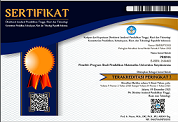Penerapan Analisis Komponen Utama dalam Penentuan Faktor Dominan yang Mempengaruhi Self-efficacy Guru Matematika dalam Menghadapi Dinamika Pembelajaran di Masa Pandemi Covid 19
Abstract
Keywords
Full Text:
PDF (Bahasa Indonesia)References
Ab. Rahim Bakar, Shamsiah Mohamed, & Noor Syamilah Zakaria. (2013). How Efficacious are They? A Study of Malaysian Novice Vocational Teachers Sense of Efficacy. Proceedings of Society for Information Technology & Teacher Education International Conference 2013, 2006, 1234–1238.
Ashton, P. T., Webb, R. B., & Doda, N. (1983). A Study of Teachers Sense of Efficacy: Final Report, Executive Summary (Report No. SP 022 818). Washington, DC: National Institute of Education.(ERIC Document Reproduction Service No. ED 231 833).
Bandura, A. (1986). Social foundations of thought and action. Englewoods Cliffs. NJ: Prentice-Hall.
Bandura, A., Freeman, W. H., & Lightsey, R. (1999). Self-Efficacy: The Exercise of Control. Journal of Cognitive Psychotherapy, 13(2), 158–166. https://doi.org/10.1891/0889-8391.13.2.158
Bruce, C. D., Esmonde, I., Ross, J., Dookie, L., & Beatty, R. (2010). The Effects of Sustained Classroom-Embedded Teacher Professional Learning on Teacher Efficacy and Related Student Achievement. Teaching and Teacher Education, 26(8), 1598–1608. https://doi.org/10.1016/j.tate.2010.06.011
Ghaith, G., & Yaghi, H. (1997). Relationships Among Experience, Teacher Efficacy, and Attitudes toward The Implementation of Instructional Innovation. Teaching and Teacher Education, 13(4), 451–458. https://doi.org/10.1016/S0742-051X(96)00045-5
Ginting, F. (2016). Penerapan Analisis Komponen Utama dalam Penentuan Faktor Dominan yang Mempengaruhi Prestasi Belajar Siswa (Studi Kasus: SMAN 2 MEDAN). UNIMED.
Hardika, J., Sebayang, D., & Sembiring, P. (2013). Penerapan Analisis Komponen Utama dalam Penentuan Faktor Dominan yang Mempengaruhi Prestasi Belajar Siswa (Studi Kasus: SMAN 1 Medan). Saintia Matematika, 1(6), 507–516.
Inayah, S., Juandi, D., Siswanto, R. D., & Morin, S. (2022). Self-Efficacy Guru Matematika dalam Menghadapi Dinamika Pembelajaran di Masa Pandemi Covid-19. JPMI (Jurnal Pembelajaran Matematika Inovatif), 5(2), 439–450.
Johnson, R. A., & Wichern, D. W. (2014). Applied Multivariate Statistical Analysis (Vol. 6). Pearson London, UK:
Klassen, R. M., & Tze, V. M. C. (2014). Teachers’ Self-Efficacy, Personality, and Teaching Effectiveness: A Meta-Analysis. Educational Research Review, 12, 59–76.
https://doi.org/10.1016/j.edurev.2014.06.001
Klassen, R. M., Tze, V. M. C., Betts, S. M., & Gordon, K. A. (2011). Teacher Efficacy Research 1998-2009: Signs of Progress or Unfulfilled Promise? Educational Psychology Review, 23(1), 21–43. https://doi.org/10.1007/s10648-010-9141-8
Midgley, C., Feldlaufer, H., & Eccles, J. S. (1989). Change in Teacher Efficacy and Student Self- and Task-Related Beliefs in Mathematics During the Transition to Junior High School. Journal of Educational Psychology, 81(2), 247–258. https://doi.org/10.1037/0022-0663.81.2.247
Pellegrino, J. W., & Hilton, M. L. (2013). Education for Life and Work: Developing Transferable Knowledge and Skills in The 21st Century. In Education for Life and Work: Developing Transferable Knowledge and Skills in the 21st Century. National Academies Press. https://doi.org/10.17226/13398
Rohmah, W. N., Septian, A., & Inayah, S. (2020). Analisis Kemampuan Penalaran Matematis Materi Bangun Ruang Ditinjau Gaya Kognitif Siswa Menengah Pertama. PRISMA. https://doi.org/10.35194/jp.v9i2.1043
Ross, J. A. (1992). Teacher Efficacy and the Effects of Coaching on Student Achievement. Canadian Journal of Education / Revue Canadienne de l’éducation, 17(1), 51. https://doi.org/10.2307/1495395
Schwarzer, R., & Hallum, S. (2008). Perceived Teacher Self-Efficacy as A Predictor of Job Stress and Burnout: Mediation Analyses. Applied Psychology, 57(SUPPL. 1), 152–171. https://doi.org/10.1111/j.1464-0597.2008.00359.x
Septian, A., & Monariska, E. (2021). The Improvement of Mathematics Understanding Ability on System Of Linear Equation Materials and Students Learning Motivation using Geogebra-Based Educational Games. Al-Jabar : Jurnal Pendidikan Matematika, 12(2), 371–384. https://doi.org/10.24042/ajpm.v12i2.9927
Supranto, J. (2010). Analisis Multivariat Arti dan Interprestasi, cet. Kedua. Jakarta: Rineka Cipta.
Thoonen, E. E. J., Sleegers, P. J. C., Peetsma, T. T. D., & Oort, F. J. (2011). Can teachers motivate students to learn? Educational Studies, 37(3), 345–360. https://doi.org/10.1080/03055698.2010.507008
Tschannen-Moran, M., & Hoy, A. W. (2001). Teacher efficacy: Capturing an elusive construct. Teaching and Teacher Education, 17(7), 783–805. https://doi.org/10.1016/S0742-051X(01)00036-1
Tschannen-Moran, M., & Hoy, A. W. (2007). The Differential
Antecedents of Self-Efficacy Beliefs of Novice and Experienced Teachers. Teaching and Teacher Education, 23(6), 944–956. https://doi.org/10.1016/j.tate.2006.05.003
Tschannen-Moran, M., Hoy, A. W., & Hoy, W. K. (1998). Teacher Efficacy: Its Meaning and Measure. Review of Educational Research, 68(2), 202–248. https://doi.org/10.3102/00346543068002202
Vandermaas-Peeler, M., Nelson, J., & Bumpass, C. (2007). Quarters Are What You Put into The Bubble Gum Machine: Numeracy Interactions During Parent-Child Play. Early Childhood Research and Practice, 9(1).
Weiner, I. B., & Craighead, W. E. (2010). The Corsini Encyclopedia of Psychology. In Choice Reviews Online (Vol. 47, Issue 11). John Wiley & Sons. https://doi.org/10.5860/choice.47-6008
Yoon, S. Y., Evans, M. G., & Strobel, J. (2012). Development of The Teaching Engineering Self-Efficacy Scale (TESS) for K-12 teachers. ASEE Annual Conference and Exposition, Conference Proceedings, 25–466. https://doi.org/10.18260/1-2--21224
Yuliana, Y., Anindita, H. A., & Syaifuddin, M. W. (2021). Pengaruh Konsentrasi Belajar dan Lingkungan Belajar terhadap Hasil Belajar Matematika pada Pembelajaran Daring. PRISMA, 10(2), 141–155. https://doi.org/10.35194/jp.v10i2.1732
Zee, M., & Koomen, H. M. Y. (2016). Teacher Self-Efficacy and Its Effects on Classroom Processes, Student Academic Adjustment, and Teacher Well-Being: A Synthesis of 40 Years of Research. Review of Educational Research, 86(4), 981–1015. https://doi.org/10.3102/0034654315626801
DOI: https://doi.org/10.35194/jp.v11i1.2054
Refbacks
- There are currently no refbacks.
Copyright (c) 2022 PRISMA
Prisma Indexing :Â

PRISMA by UNIVERSITAS SURYAKANCANA is licensed under a This work is licensed under a Creative Commons Attribution-ShareAlike 4.0 International License.Based on a work at https://jurnal.unsur.ac.id/prisma.


1.jpg)








